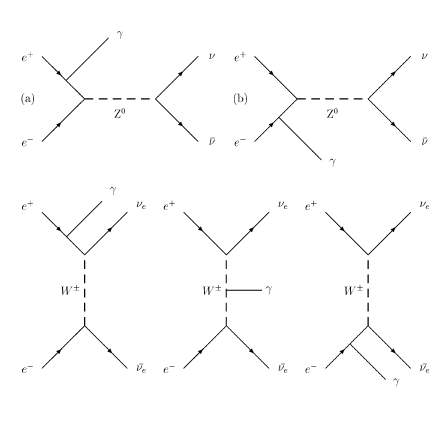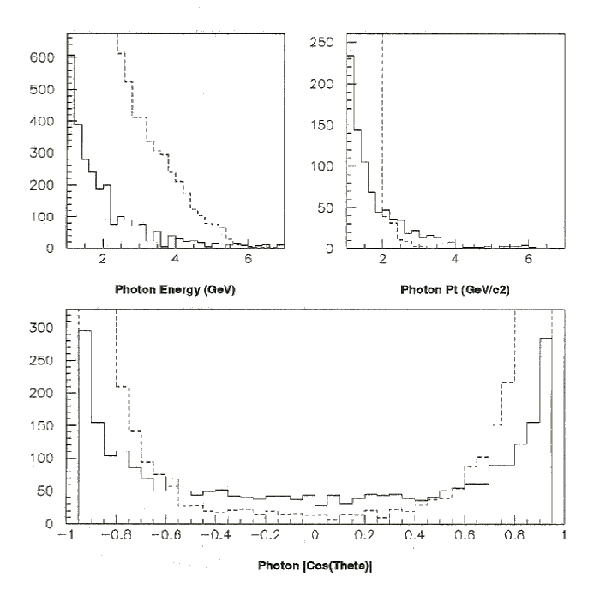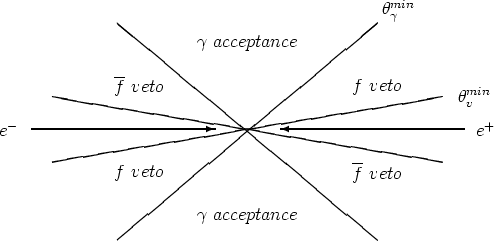


Chapter 2
Theoretical Background
Since the neutral weak vector boson, Z0, couples to all fermion and
anti-fermion pairs, it is an ideal particle for measuring and studying the
electromagnetic, weak, and strong interactions.
In the framework of electron-positron colliders operating at center-of-mass
energies near the MZ0, i.e. Ös » MZ0, copious numbers of
Z0 particles are produced.
The Z0 particles subsequently decay into fermion, f, and anti-fermion,
[`(f)], pairs via
e+e- ® (Z0) ® f[`(f)].
The coupling of the Z0 is characterized by the total decay rate, GZ0tot,
into fermion and anti-fermion pairs with mass mf £ MZ0/2 according to
where
|
|
| | |
NfC |
MZ0
12p
|
Ö2GFMZ02 |
Ö
|
1-4mf
|
|
é
ë
|
(If3-2Qfsin2 |
-
q
|
W
|
)2(1+2mf) + (1-4mf) |
ù
û
|
|
|
|
|
| (2.2) |
with
|
|
| | |
| | |
the Fermi coupling constant |
|
| | |
the weak correction coefficient |
|
| | |
| | |
the third component of the weak isospin of the particle |
|
| | |
the charge of the particle |
|
| | |
the sine square of the weak mixing angle , qw |
|
|
|
|
The total decay rate or width of the Z0, GZ0tot, must be corrected to include
the secondary effects due to the electromagnetic (QED), weak, and
quantum chromodynamics (QCD) interactions.
The corrections are normally included by defining parameters to incorporate
the differences from the ``bare'' calculation permitting the evaluation of the
different partial decay rates.
Such effects are called radiative corrections and naturally divide into three
areas for the general process e+e-® Z0® f[`(f)] as
follows:
(1) QED Corrections: The corrections due to initial or final state
Bremsstrahlung consisting of those diagrams with an extra photon added as
either a real or virtual photon loop.
The initial state radiative corrections change the center-of-mass energy of
the collision and consequently has a large effect on the line-shape
normalization at LEP.
The final state radiative corrections have a small effect at LEP of
~ (3aQ2f)/4p £ 0.17%.
(2) Weak Corrections: The corrections due to all other electroweak
diagrams including corrections due to the vector boson propagators g and Z0, the set of
vertex corrections, and box diagrams with two massive boson exchange.
(3) QCD
Corrections: The corrections due the final state gluon radiation which
changes the Z0 width by ~ as/4p » 4%.
For example, the QED corrections are normally
re-absorbed by defining the effective weak mixing angle, [`(q)]W, while the weak corrections are re-absorbed in
the r parameter. The agreement
between the corrected predictions of the Standard Model and the most recent
experimental results of today [22] gives strong support for the SM. This chapter
presents an overview of the different methods for determining the number of
elementary light neutrinos, Nn, with
mn £ MZ0/2 in the framework of the
electron-positron collider LEP (described in Chapter 3).
2.1 Theory of Neutrino Counting
Since the neutrino is the lightest member
of each family coupling directly to the Z0, it is an ideal
particle to count at electron-positron colliders for determining the number of
elementary particle families. At least two of the different ways to count the
number of elementary light neutrinos are:
(1) The Invisible Width Method: The method of measuring
the invisible width of Z0, GZ0inv, from the total
width, GZ0tot, the hadronic width, GZ0had, and the leptonic
width, GZ0leptassuming all contributions from the
invisible channels originate from light neutrinos, GZ0inv=NnGn[`(n)] [14].
(2) The Single Photon Counting
Method: The method of measuring the total cross-section for the process e+e-® n[`(n)]g which is directly proportional to the
number of light neutrinos [19].
It is important to realize the complementarity between
the different methods from the theoretical and experimental point of view which
results in producing independent determinations of Nn. The direct and indirect methods use
different theoretical inputs from the SM resulting in differing accuracy for the
determination of the number of light neutrinos, Nn, according to the statistical and systematic
constraints of the experiment. The single photon counting method has the
advantage over the other methods in that only the neutrino partial width Gnn enters directly in the cross-section,
resulting in a determination of Nn which is only weakly affected by
experimental and theoretical uncertainties. Since the analysis presented in this
thesis determines the number of light neutrinos using the single photon counting
method, attention is placed on its theoretical discussion in Section 2.3.
2.2 The Invisible Width Method
The invisible width method precisely determines the
number of neutrino families from the decomposition of the total width, GZ0tot, into its partial widths. In the SM, the
total width is decomposed into the invisible width, GZ0inv, the hadronic width,
GZ0had, and the leptonic width, GZ0lept, as follows:
|
|
|
|
| GZ0tot=NnGZ0inv+GZ0had+GZ0lept
| | |
| |
(2.3) |
where
|
|
|
|
| GZ0e+e-+GZ0m+m- + GZ0t+t- | | |
| |
(2.4) |
Assuming that
all contributions from the invisible channels originate from neutrinos, the
invisible width, GZ0inv, is given by
|
|
|
|
| GZ0tot - GZ0had - GZ0lept
| | |
| |
(2.5) |
and the
number of elementary light neutrinos, Nn, is
of the form
As a direct
result of the radiative corrections on the GZ0, the values
of the top mass (mt), Higgs mass (mH), and the strong
coupling constant (as) bear on the accuracy
of the Nn measurement. If one varies mH between 2 and 1000 GeV, mt between 50 and 450 GeV, and as between 0.09 and 0.15, the theoretical
uncertainty of GZ0 amounts to 0.030 GeV where GZ0 =2.492±0.017 GeV [23].
Experimental measurements of GZ0tot have been made
with the high statistics samples of the Z0 collected
from the LEP collider as shown in Table 1.3. The accuracy of the
determination of the number of light neutrinos depends largely on the different
experimental conditions and the theoretical inputs from the SM [15] [16] [17] [18]. The
experimental inputs important to the determination of Nn shown in Table 1.3
include MZ0, R¢, and
L,
with the theoretical input GZ0n[`(n)](theor.). Here,
R¢ is defined as
|
|
|
|
|
GZ0had(exp.)
GZ0mm(exp.)
|
= |
emm Nhad
ehad Nmm
|
| | |
| |
(2.7) |
Here ehad and emm are the hadronic and leptonic efficiencies.
Nhad and Nmm are the numbers of hadronic and
leptonic events respectively.
By parametrizing the observed hadronic cross-section
sobshad as
|
|
|
|
|
ó
õ |
s
smin
|
shad(s¢) f(s,s¢) ds¢ | | |
| |
(2.8) |
with
|
|
|
|
| spolehad |
s MZ02
(s¢- MZ02)2 + s¢2G2Z0 / MZ02
|
| | |
| |
(2.9) |
With shadpole from measurement, the invisible width is
given by
|
|
|
|
| GZ0tot |
é
ê
ë
|
1 - 3 |
æ
ç
è
|
æ
Ö
|
|
ö
÷
ø
|
- |
Nhad
ehad
|
|
æ
ç
è
|
æ
Ö
|
|
ö
÷
ø
|
ù
ú
û
|
| | |
| |
(2.10) |
where L is the
integrated luminosity and F @ ([(G)/(M)])b with
b = (( 2 a)/(p
)) ln(( s)/(m2 )). The error on
DGZ0inv is
|
|
|
|
| (0.5 GZ0had-1.5 GZ0m+m-) |
æ
è |
DNmm
Nmm
|
Å |
Demm
emm
|
ö
ø |
ÅGZ0had |
æ
è |
DNhad
Nhad
|
Å |
Dehad
ehad
|
ö
ø |
| |
|
|
|
| ( 0.5 GZ0had+ 1.5 GZ0m+m- ) |
æ
è |
DL
L
|
ö
ø |
ÅGZ0inv |
DGZ0tot
GZ0tot
|
| | |
| |
(2.11) |
where Å refers to the addition of errors in
quadrature.
Experimental results using the invisible width method
have achieved dNn =0.01
with DL /L = 1% and Dehad / ehad = Dem /
em=1% with a L=10 pb-1. However, the method does not
give the correct answer if Nn ¹ GZ0inv/ GZ0n[`(n)] , because of the initial assumption on
GZ0inv. Hence, an independent determination of Nn is needed as a check against any
possible new invisible particles.
2.3 The Single Photon Counting Method
The single photon counting method
directly measures the cross-section for the Z0 to decay
into invisible particles, i.e. neutrino and anti-neutrino pairs, by counting the
number of events with a single visible photon radiated before the decay of the
Z0 [19]. From the
single photon cross-sections determined at different center-of-mass energies, a
fit to the data points yields a determination of the number of light neutrinos,
Nn, with mn £ MZ0/2. The invisible width of the Z0 decay, GZ0inv, is then determined
in the SM from the measured value of the number of light neutrinos, Nn. The advantage of the invisible width method
over the previous methods is that the experimental and the theoretical
uncertainties only weakly affect the final answer, since only the neutrino
partial width GZ0n[`(n)] enters directly in the reaction.
2.3.1 The Lowest Order Cross-Section
The first order Feynman diagrams in the SM that
contribute to the process e+e-® n[`(n)]g are shown in Figure 2.1.
The interaction Hamiltonian of the two Z0 decay
diagrams for the single photon process, e+e-® n[`(n)]g,
is given by
|
|
|
|
|
GF
2
|
si
[ niga (1-g5)ni
][ e ga (gvi
- gai
g5)e
] | | |
| |
(2.12) |
From this
interaction Hamiltonian, the differential cross-section for the production of a
photon forming an angle with respect to the beam axis, y=cosqg, and energy, x=2Eg/Ös, is given
by the following formula,
|
|
|
|
| G2F as(1-x) |
[
(1- x/2)2 + x2y2/4 ]
6 p2 x (1-y2)
|
| |
|
|
|
|
é
ë |
2+ |
Nn( gv2+ga2 )+ 2 ( gv+ga ) ( 1 - s(1-x) / MZ02 )
( 1 - s(1-x) / MZ02 )2 + GZ0/ MZ02
|
ù
û |
| | |
| |
(2.13) |
where
|
|
|
|
| the fraction of energy carried away by the emitted photon ( 2Eg / Ös)
| |
|
|
|
| the emitted photon angle with respect to the beam axis (cosqg)
| |
|
|
|
| the vector coupling constants (-1/2+2sin2DqW
» -0.04)
| |
|
|
|
| the axial coupling constants (-1/2)
| |
|
|
|
| the number of light neutrinos with mn < MZ0/2 | | |
| |
Figure 2.1: Lowest Order Feynman Diagrams for the
Process e+e-® n[`(n)]g.The two sets of
Feynman diagrams which contribute in lowest order to the process e+e-® n[`(n)]g.
The Z0 exchange diagrams shown in (a) allow for the
production of any type of light neutrino with mn £ MZ0/2, whereas the W± exchange diagrams shown in (b) produce
only electron neutrinos, ve.
2.3.2 Single Photon Spectra
Figure 2.2 shows the center-of-mass dependence for the
e+e-® n[`(n)]g signal and the principal background, the
radiative Bhabha process, e+e-® e+e-g. A feature of the general form of the
spectra for the single photon signal is the the energy distribution which is
soft divergent, i.e. d s/ d x µ 1 /
x, and strongly forward/backward peaked angular
distributions indicative of radiative processes, i.e. d s/ d y µ 1 / sin2qg. The
selection criteria must attempt to utilize these attributes to accept as much of
the single photon signal from the e+e-® n[`(n)]g process while reducing as much as possible
any other type of event with the same topology and signature, namely the
backgrounds. Among the most important backgrounds for the single photon signal
is the e+e-® e+e-g process shown in Figure 2.2. The
selection criteria are discussed in greater detail in Chapter 6.
Figure 2.2: Single Photon Spectra for the Process
e+e-® n[`(n)]g.The energy (a),
transverse momentum (b), and polar angle (c) spectra from the single photon
process e+e-® n[`(n)]g are shown with solid histograms for Ös ~ MZ0 where
Eg ³ 1.0 GeV and cos(qe±) £ 0.999. Shown by the dashed histograms are the
spectra for the dominant background, i.e. the low Q2 radiative Bhabha
scattering e+e-® e+e-g.
In the partial cross-section for the single photon
signal, the Z0 pole at x=(s-MZ02)/s leads to a
pronounced enhancement in the energy distribution for center-of-mass energies
above the MZ0, e.g. Ecm
» MZ0+7 GeV. In fact, the total
cross-section given by Equation 2.13 increases by about 30% as a function of each
additional neutrino family. This large change in the total cross-section,
however, must be modified due to the inclusion of the O(a)
virtual and real contributions from the the electroweak radiative corrections to
the single photon signal. Since this analysis uses data taken at center-of-mass
energies near the MZ0, e.g. Ecm
» MZ0±3 GeV, attention is focused on the signal and
corrections to the signal for Ecm » MZ0±3 GeV. The partial cross-section for
the single photon signal from the process e+e-® n[`(n)]g has been determined using the point
interaction approximation in the limit of MW ® ¥.
For the center-of-mass energies considered in the analysis, i.e. MZ0-3.0 GeV £ Ös £ MZ0+3.0 GeV, this approximation
is justified since it affects the total cross-section by is less than 1%.
The Electroweak Radiative
Corrections
The electroweak radiative corrections affect both the
shape and the position of the peak around the Z0 [24]. The weak
corrections can be absorbed in the single photon total cross-section through the
r parameter, the effective sin2[`(q)]W, and the modified Z0 propagator [25]. The total
shift of the peak of the MZ0 due to the weak corrections is 35 MeV
over the expression with constant GZ [14]. The
electromagnetic radiative corrections have the same type of corrections as those
for the Z0 line shape, but are much simpler in structure,
since the e+e-® n[`(n)]g signal has no charged final states. The
formalism of structure functions has been used to calculate the corrected single
photon cross-section. In this scheme, s0(s¢) is
the ``reduced'' cross-section for the process e+e-® n[`(n)]g in the new center of mass system given by s¢= (1-x)s = s-2EgÖs. Introducing functions with transverse degrees
of freedom renders the ``reduced'' partial cross-section in the form [26]:
|
|
|
|
| H(a)(x,y;s) s0 ( (1-x)s
) = H(a)(x,y;s¢) s0 ( s¢) | | |
| |
(2.14) |
where the
``reduced'' cross-section has the form
|
|
|
|
|
GF2 s¢
12 p
|
|
é
ë |
2 +
Nn( gv2+ga2 ) + 2 ( gv+ga ) ( 1 - s¢/ MZ02 )
( 1 - s¢/ MZ02 )2 + GZ0/ MZ02
|
ù
û |
| |
|
|
|
|
12p
MZ02
|
|
é
ë |
Nns¢GZ0n[`(n)]
( s¢- MZ02 )2 + s¢2GZ0tot2 / MZ02
|
ù
û |
+ W terms
| | |
| |
(2.15) |
and the radiator function, H(a)(x,y;s¢), given by the expression [27]
|
|
|
|
|
a
p
|
|
1+(1-x)2
x
|
|
1
1-y2
|
Q |
æ
è |
1- |
4 m2(1-x)
s¢
|
-|y | |
ö
ø |
| | |
| |
(2.16) |
In the structure function formalism, the total
cross-section for producing a real photon can be written by integrating
Equation 2.16.
|
|
|
|
|
ó
õ |
1
xmin
|
dx |
ó
õ |
+ymin
-ymin
|
dy H(a)(x,y;s) s0 ( (1-x)s
) | | |
| |
(2.17) |
where the
minimum detectable energy and angle of the photon is given by xmin = 2Eming/Ös and ymin=cos(qming) as shown in Figure 2.3.
Although the resummation of the collinear and soft photon affects the
distributions by a few percent, the total cross-section of the observed single
photon is reduced to 75% of the Born approximation as a result of the O(a)
radiative corrections.
Figure 2.3: The Experimental Setup for the Process
e+e-® n[`(n)]g.The experimental
setup for the detection of the single photon events is directly affected by the
angle below which no particle can be detected, qvmin, the fiducial volume for acceptance of the
single photons, qgmin, and the minimum
detection energy of the single photon, Egmin.
The total cross-section is also affected by the choice
of the single photon selection criteria (refer to Figure 2.3). The
selection criteria aim at carefully selecting as much of the single photon
events from the signal process, while removing as much of the background as
possible. Among the most important background to the single photon signal is the
low Q2 radiative
Bhabha scattering, e+e-® e+e-g, where the photon is observed in the
acceptance volume while the electron and positron escape detection down the beam
pipe. A natural choice for vetoing such events would be to cut as high as
possible with the veto angle, but for center-of-mass energies near the MZ0 this
also eliminates much of the signal. Consequently, the elimination of the low Q2 radiative Bhabha
background, along with the other possible backgrounds, requires the use of Monte
Carlo event generators or analytical programs to correctly study and determine
the best method for selecting the single photon events from the process e+e-® n[`(n)]g.
This will be discussed in detail in Chapter 6.






